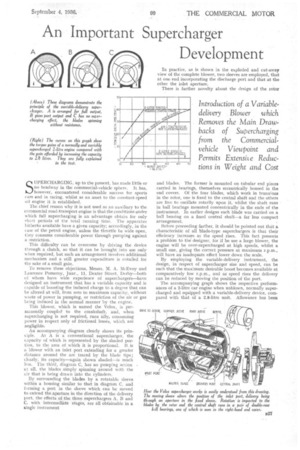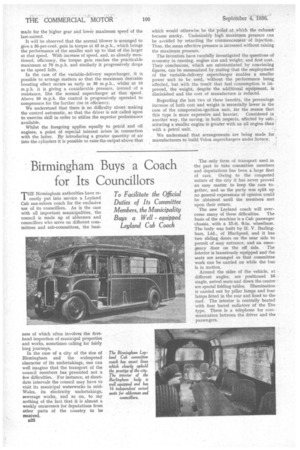An Important Supercharger Development
Page 41

Page 42

If you've noticed an error in this article please click here to report it so we can fix it.
SUPERCHARGING, up to the present, has made little or no headway in the commercial-vehicle sphere. It has, however, encountered -considerable success for sports ears and in racing, whilst as an asset to the constant-speed oil engine it is established.
The chief reason why it is not used as an auxiliary to the commercial road-transport engine is that the conditions under which full supercharging is an advantage obtain for only short periods of the total running time. The apparatus hitherto available have a given capacity; accordingly, in the case of the petrol engine, unless the throttle he wide open, they consume considerable power through pumping against a restriction.
This difficulty can be overcome by driving the device through a clutch, so that it can be brought into use only when required, but such an arrangement involves additional mechanism and a still greater expenditure is entailed for the sake of a small gain.
To remove these objections, Messrs. M. A. McEvoy and Laurence Pomeroy, Junr., 11, Dexter Street, Derby—both of whom have wide experience of superchargers—have designed an instrument that has a variable capacity and is capable of boosting the induced charge to a degree that can be altered at will, from zero to maximum capacity, without waste of power in pumping, or restriction of the air Or gas being induced in the normal manner by the engine.
This blower, which is named the Velox, is permanently coupled to the crankshaft, and, when supercharging is not required, runs idly, consuming power in respect only of frictional losses, which are negligible.
An accompanying diagram clearly shows its principle. At A is a conventional supercharger, the capacity of which is represented by the shaded portion, to the area of which it is proportional. B is a blower with an inlet port extending for a greater distance around the arc traced by the blade tips ; clearly, its capacity—again shown shaded—is much less. The third, diagram C, has no pumping action at all, the blades simply spinning around with the air that is being drawn into the cylinders.
By surrounding the blades by a rotatable sleeve within a housing similar to that in diagram C, and forming a port in the sleeve which can be moved to extend the aperture in the direction of the delivery port, the effects of the three superchargers A, B and C. with intermediate stages, are all obtainable in a single instrument.
and blades. The former is mounted on tubular end pieces carried in bearings, themselves eccentrically housed in the end covers. Of the four blades, which work in trunn4ons in the rotor, one is fixed to the central shaft and the others are free to oscillate rotarily upon it, whilst the shaft runs in ball bearings mounted concentrically in the ends of the instrument. In earlier designs each blade was carried on a bail bearing on a fixed central shaft—a far less compact arrangement.
Before proceeding farther, it should be pointed out that a characteristic of all blade-type superchargers is that their efficiency increases as the speed rises. This fact presents a problem to the designer, for if he use a large blower, the engine will be over-supercharged at high speeds, whilst a small one, giving the correct pressure at maximum r.p.m., will have an inadequate effect lower down the scale.
By employing the variable••delivery instrument, the design, in respect of supercharger size and speed, can be such that the maximum desirable boost becomes available at comparatively low r.p.m., and as speed rises the delivery can be reduced by moving the position of the port.
The accompanying graph shows the respective performances of a 2-litre car engine when unblown, normally supercharged and equipped with a variable-delivery device, compared with that of a 2.8-litre unit. Allowance has been made for the higher gear and lower maximum speed of the last-named,
It wilt be observed that the normal blower is arranged to give a 30-per-cent. gain in torque at 45 m.p.h., which brings the performance of the smaller unit up to that of the larger at that speed. With increase of speed, and, as already mentioned, efficiency, the torque gain reaches the practicable maximum at 70 m.p.h. and similarly it progressively drops as the speed falls.
In the case of the variable-delivery supercharger, it is possible to arrange matters so that the maximum desirable boosting effect occurs as early as 30 m.p.h., whilst at 10 m.p.h. it is giving a considerable pressure, instead of a resistance, like the normal supercharger at that speed. Above 30 m.p.h. the control is progressively operated to compensate for the further rise in efficiency.
We understand that there is no difficulty about making the control automatic, so that the driver is not called upon to exercise skill in order to utilize the superior performance available.
Whilst the foregoing applies equally to petrol and oil engines, a point of especial interest arises in connection with the latter. By introducing a greater quantity of air into the cylinders it is possible to raise the output above that which would otherwise be the point at which the exhaust became smoky. Undesirably high maximum pressure can be avoided by retarding the commencement of injection. Thus, the mean effective pressure is increased without raising the maximum pressure.
The inventors have carefully investigated the questions of economy in running, engine size and weight, and first cost. Their conclusions, which are substantiated by convincing figures, can be summarized by stating that the employment of the variable-delivery supercharger enables a smaller power unit to be used, without the performance being affected, but with the result that fuel consumption is improved, the weight, despite the additional equipment, is diminished and the cost of manufacture is reduced.
Regarding the last two of these benefits, the percentage increase of both cost and weight is materially lower in the case of the compression-ignition unit, for the reason that this type is more expensive and heavier. Considered in another way, the saving, in both respects, effected by substituting a smaller engine is greater with an oil engine than with a petrol unit.
We understand that arrangements are being made for manufacturers to build Velox superchargers under licence.




























































































